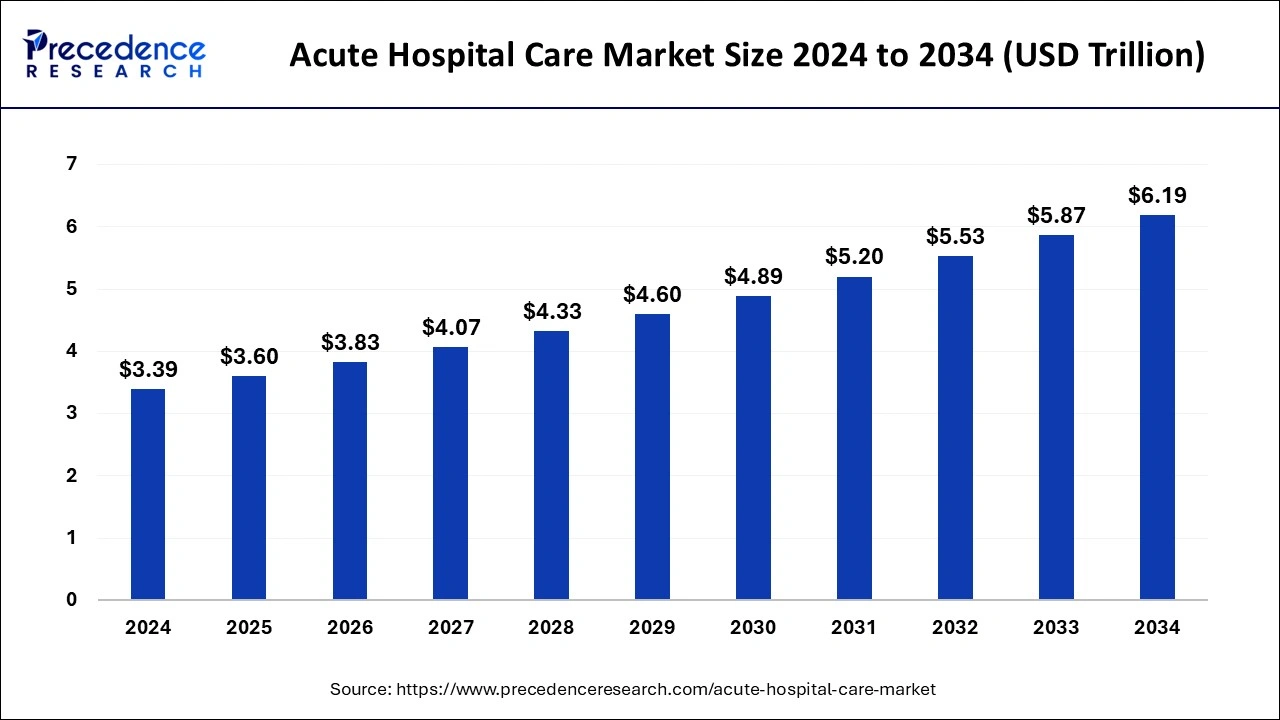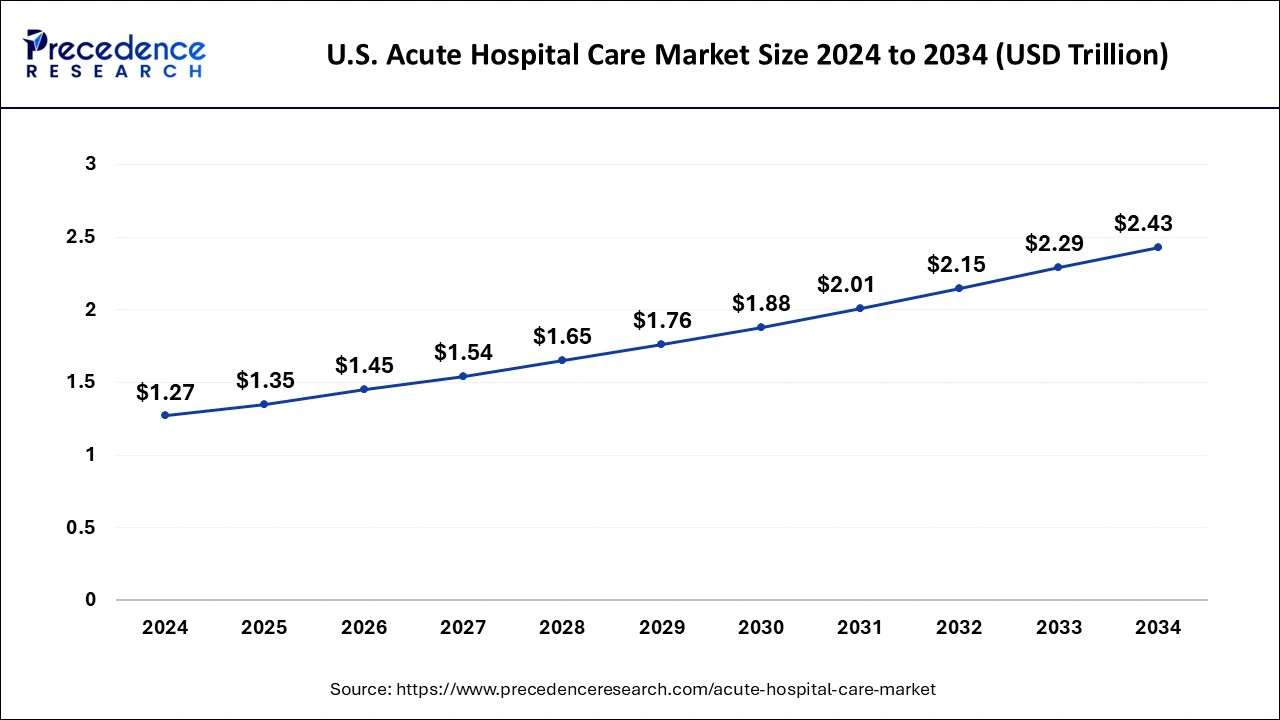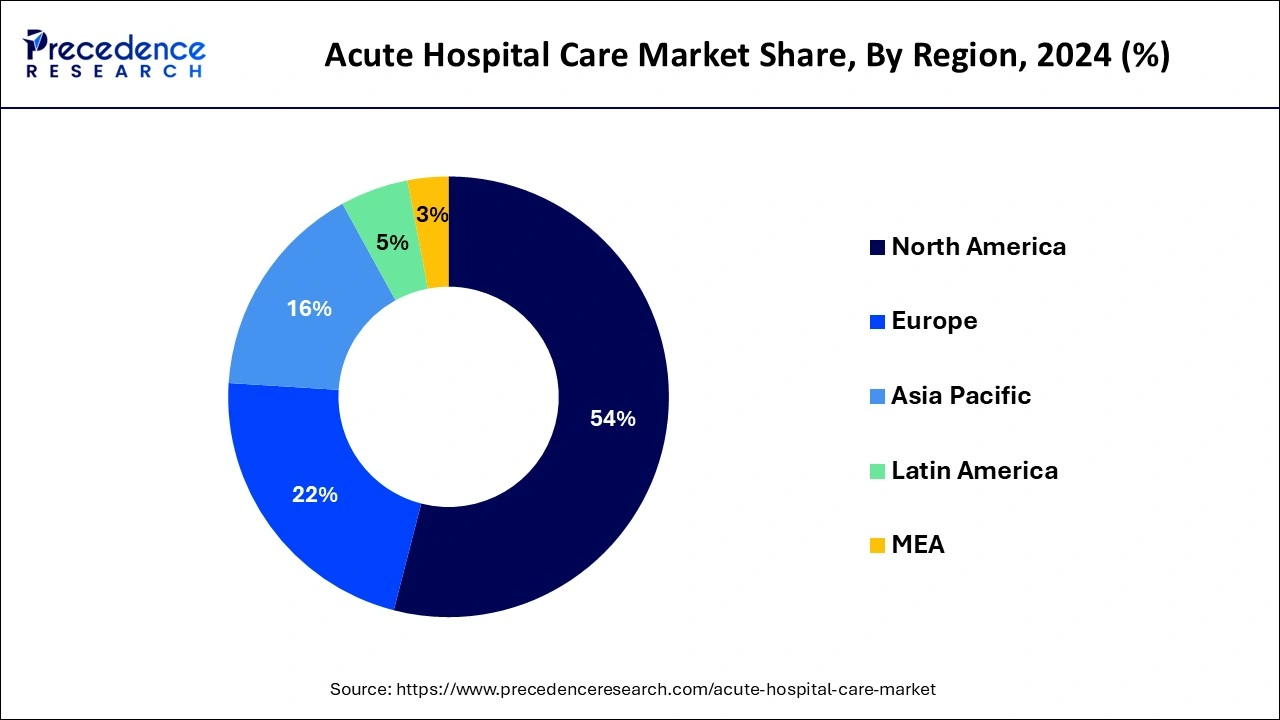List of Contents
What is the Acute Hospital Care MarketSize?
The global acute hospital care market size is calculated at USD 3.60 billion in 2025 and is predicted to increase from USD 3.83 billion in 2026 to approximately USD 6.19 billion by 2034, expanding at a CAGR of 6.21% from 2025 to 2034.

Acute Hospital Care Market Key Takeaways
- North America region hit a revenue share of 53.14% in 2024.
- Europe region accounted for 22.41% of revenue share in 2024.
- By medical condition, the emergency care segment accounted for the highest revenue share in 2024.
- The acute care surgery segment is growing at a CAGR of 6.45% between 2025 and 2034.
- By facility type, the general acute care hospitals segment generated the highest revenue share in 2024.
- The psychiatric hospitals segment is expected to grow at a CAGR of 6.8% from 2025 and 2034.
- By services, the Intensive Care Unit (ICU) segment dominated the market with the highest revenue share in 2024.
- The NICU segment is expected to hit at a CAGR of 6.31% over the forecast period 2025 and 2034.
The Frontline of Healing: The Ascendant Landscape of Acute Hospital Care
The acute hospital care market is experiencing significant growth as global healthcare systems adapt to increasing disease complexity, demographic changes, and rising patient expectations. Acute care facilities, once primarily focused on emergency response, are now evolving into integrated centers for advanced diagnostics, critical care, surgical expertise, and quick rehabilitation. The market's growth is fueled by aging populations, lifestyle-related illnesses, and the adoption of high-acuity technologies that improve clinical precision and patient recovery. As digital health tools revolutionize hospital workflows, acute care is positioned to become the core of modern medical ecosystems.
Acute Hospital Care Market Growth Factors
Rising prevalence of chronic diseases, increasing inpatient volume, and favorable reimbursement policies available for the services through Medicaid and Medicare are the key factors that drive the overall market growth. Increasing incidence of trauma, increasing geriatric patient volume, increasing demand for acute care hospitals, and unmet medical needs in developing countries projected to boost the market growth. An increase in the inpatient volumes because of prevalence of chronic diseases across the globe is stimulating hospitals to work actively towards reducing the Turnaround Time (TOT) and Length of Stay (LOS).
As emergency rooms at hospitals have become increasingly crowded with an average of 55 minutes wait time because of this more patients are showing interest in high-deductible health plans, requirement for acute hospitals has increased specifically for patients with severe medical conditions.
The American Academy of Orthopedic Surgeon reported that bone fracture is a common injury and nearly 6 million people suffer from it every year in the United States.Out of these, only 300,000 patients receive acute hospital care. Acute hospital care aims to help patients attain stable &healthy medical condition as well as discharging the patient in minimum possible time. As per World Health Organization (WHO), nearly 80% of total deaths because of cardiovascular diseases occur in emerging countries. The aforementioned factors anticipated o propel the overall market growth for acute hospital care in the coming years.
Market Outlook
- Industry Growth Overview: The acute hospital care market is expected to experience rapid growth due to the rising demand for advanced diagnostics, chronic disease management, and emergency response capacity. Industry players are advancing toward scalable models that combine operational efficiency with clinical excellence. Private operators are expanding their geographic presence, while public systems prioritize infrastructure reinforcement and emergency preparedness, further driving market growth.
- Sustainability Trend: Sustainability is becoming a key part of modernizing acute care. Energy-efficient hospital buildings, green ICU designs, recyclable medical supplies, and low-waste surgical practices are transforming how facilities operate. Hospitals are adopting renewable energy, eco-friendly sterilization methods, and water-saving strategies. Carbon-neutral hospital campuses and sustainable purchasing policies are increasingly important as differentiators.
- Major Investors: Major investors in the market include private equity firms, foreign direct investors, and institutional healthcare focused investment funds. By injecting capital into hospital chains, enabling expansion of bed capacity, modernization of facilities, and acquisitions, they help scale operations, improve the quality of care, and increase access to acute care services across regions.
- Global Expansion: The market is growing globally due to rising incidence of chronic and acute diseases, aging populations, and increasing demand for emergency and critical‑care services, all of which drive higher hospital admissions and the need for advanced acute care facilities and technologies. Emerging regions, especially in Asia, Latin America, and Africa, offer significant opportunities as governments and private investors ramp up healthcare infrastructure, expand insurance coverage, and invest in modern hospital facilities to address unmet care demand.
Acute Hospital Care Market Scope
| Report Highlights | Details |
| Market Size in 2025 | USD 3.60 Trillion |
| Market Size in 2026 | USD 3.83 Trillion |
| Market Size by 2034 | USD 6.19 Trillion |
| Growth Rate from 2025 to 2034 | CAGR of 6.21% |
| Largest Market | North America |
| Fastest Growing Market | Asia Pacific |
| Base Year | 2024 |
| Forecast Period | 2025 to 2034 |
| Segments Covered | Vehicle Class, and Architecture |
| Regions Covered | North America, Europe, Asia-Pacific, Latin America, and Middle East & Africa |
Segment Insights
Medical Condition Insights
Emergency care segment exhibits its dominance in terms of revenue for the year 2023 and expected to have considerable growth during the forthcoming years. Rising prevalence of communicable diseases, increasing cases of burn & trauma injuries, and increase in the number of patients suffering from cardiovascular disease are the key factors that contribute prominently towards the growth of the segment.
Moreover, wide range of services offered in the emergency treatment to the patient's suffering from life threatening condition expected to foster the market growth. Life-threatening conditions include Cerebrovascular Accident (CVA) or stroke, acute myocardial infarction or heart attack, severe bleeding, extreme difficulty in breathing, burns & lacerations, poisoning, acute abdominal pain, severe allergic reactions, broken bones, and trauma cases such as Traumatic Brain Injury (TBI).
However, short-term stabilization expected to forecast the highest growth in the coming years. This is mainly because of numerous market players focusing on reducing the time of hospital stays that consequently reduces the cost to patient along with wait time, thereby improving the service offered.
Regional Insights
U.S. Acute Hospital Care Market Size and Growth 2025 to 2034
The U.S. acute hospital care market size is exhibited at USD 1.35 trillion in 2025 and is projected to be worth around USD 2.43 trillion by 2034, growing at a CAGR of 6.70% from 2025 to 2034.

North America dominated the global acute hospital care market due to increasing patient population, well-developed technology, increasing government support for Research & Development (R&D), and high spending on health care expenditure. Furthermore, increased R&D activities along with the concentration of major market players have fuelled the market growth in this region.
Why is Europe Considered the Second-Largest Market?
Europe occupied the second position in terms of market value share owing to the government support for R&D and availability of funds for research. The above mentioned factor anticipated to drive the European market over the analysis period. For instance, developed countries such as France and Germany are investing significantly in the healthcare domain and are primarily focusing on the development of hospital infrastructure.
What Makes Asia Pacific the Fastest-Growing Region in the Market?
Apart from all above, the Asia Pacific executes the fastest growth rate during the analysis period because of rapid development in healthcare technologies, high healthcare expenditure, and huge patient population. Moreover, rising demand for acute hospital care in countries such as India, China, and South Korea are likely to boost the overall market growth. Increased demand for quality equipment in healthcare industry to early diagnose the problem and cure them propels the need for acute hospital care.
What Potentiates the Growth of the Market in the Middle East & Africa?
On the other hand, the Middle East & Africa estimated to have prominent growth over the forthcoming years owing to limited medical facilities coupled with deprived political conditions in Africa.

U.S. Market Trends
The U.S. is a major contributor to the North America acute hospital care market due to its large and advanced healthcare infrastructure, high healthcare expenditure, and well-established hospital networks. Strong demand for emergency care, surgical procedures, and treatment of chronic and acute conditions drives consistent growth in acute care services. Additionally, ongoing investments in medical technologies, specialized care units, and healthcare IT solutions enhance service quality and capacity, solidifying the U.S. leadership in the regional
Germany Market Trends
Germany is a major contributor to the Europe acute hospital care market due to its well-developed healthcare system, high healthcare expenditure, and extensive network of hospitals equipped with advanced medical technologies. Strong demand for specialized acute care services, including surgery, emergency treatment, and critical care, drives consistent utilization of hospital facilities. Additionally, government support, robust health insurance coverage, and continuous investments in medical infrastructure and innovation reinforce Germany's leading position in the regional market.
China Market Trends
China is a major contributor to the Asia Pacific acute hospital care market due to its large population, rapidly expanding healthcare infrastructure, and rising prevalence of chronic and acute diseases. Growing government investment in hospital construction, modernization, and healthcare accessibility drives increased demand for acute care services. Additionally, advancements in medical technology, the adoption of digital health solutions, and expanding health insurance coverage further strengthen China's role as a key driver in the regional market.
The MEA acute hospital care sector is expanding as governments prioritize healthcare infrastructure modernization and universal access. Investments in tertiary hospitals, trauma centers, and advanced surgical units are rapidly transforming patient care quality. The region is seeing increased adoption of high-tech imaging, ICU expansion, and AI-integrated monitoring systems. Private hospital chains are also growing, especially in the Gulf, meeting the rising demand for specialty care and medical tourism.
UAE is developing world-class acute care centers equipped with robotics, precision imaging, and advanced ICUs to support its medical tourism goals. Saudi Arabia, under Vision 2030, is expanding both government and private hospital infrastructure, with significant funding for emergency medicine and specialty acute care. South Africa continues to enhance its acute care system through public-private collaborations and improvements in trauma and infectious disease management. Egypt is focusing on upgrading district hospitals to increase access to emergency and surgical services.
Acute Hospital Care MarketCompanies
- Universal Health Services, Inc.
- Tenet Healthcare Corporation
- Community Health System
- Tenet Healthcare Corporation
- Legacy Lifepoint Health, Inc.
- Hca Healthcare, Inc.
- Ardent Health Services
- Adeptus Health Inc.
- Ascension Health
- Emerus
Segments Covered in the Report
By Facility Type
- Psychiatric Hospitals
- General Acute Care Hospitals
- Rehabilitation Hospitals
- Specialized Hospitals
- Long-term Acute Care
By Medical Condition
- Short-term Stabilization
- Emergency Care
- Acute Care Surgery
- Trauma Care
- Others
By Service
- Intensive Care Unit (ICU)
- Coronary Care Unit (CCU)
- Neonatal Intensive Care Unit (NICU)
- Others
By Geography
- North America
- U.S.
- Canada
- Europe
- U.K.
- Germany
- France
- Asia-Pacific
- China
- India
- Japan
- South Korea
- Malaysia
- Philippines
- Latin America
- Brazil
- Rest of Latin America
- Middle East & Africa (MEA)
For inquiries regarding discounts, bulk purchases, or customization requests, please contact us at sales@precedenceresearch.com
Frequently Asked Questions
Ask For Sample
No cookie-cutter, only authentic analysis – take the 1st step to become a Precedence Research client